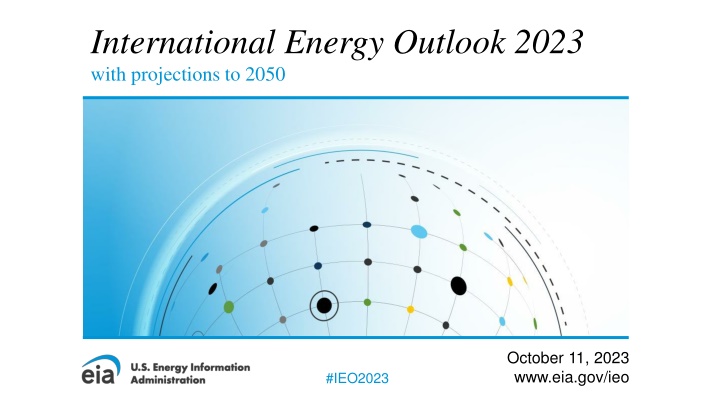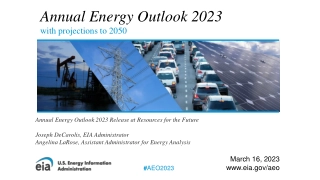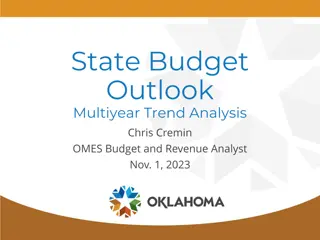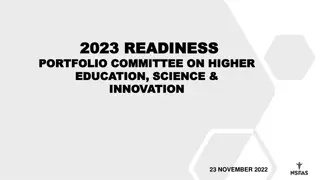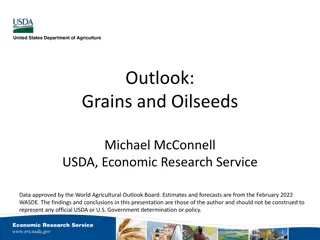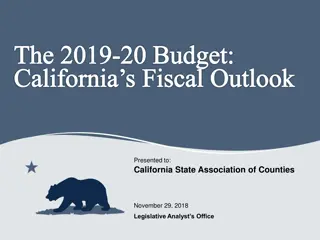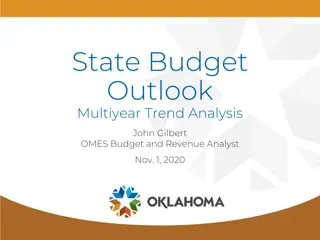International Energy Outlook 2023 Highlights and Projections to 2050
The International Energy Outlook 2023 (IEO2023) provides insights into long-term energy trends globally, focusing on narrative improvements, new cases examining zero-carbon technologies, and modeling enhancements. Various scenarios reflect economic assumptions and current regulations, projecting changes in global GDP, oil prices, and technology costs. The report emphasizes the shift to renewables, influenced by population growth, income levels, and regional factors, impacting energy security and carbon emissions.
Download Presentation

Please find below an Image/Link to download the presentation.
The content on the website is provided AS IS for your information and personal use only. It may not be sold, licensed, or shared on other websites without obtaining consent from the author.If you encounter any issues during the download, it is possible that the publisher has removed the file from their server.
You are allowed to download the files provided on this website for personal or commercial use, subject to the condition that they are used lawfully. All files are the property of their respective owners.
The content on the website is provided AS IS for your information and personal use only. It may not be sold, licensed, or shared on other websites without obtaining consent from the author.
E N D
Presentation Transcript
International Energy Outlook 2023 with projections to 2050 October 11, 2023 www.eia.gov/ieo #IEO2023
What does EIA do? The U.S. Energy Information Administration (EIA) is the statistical and analytical agency within the U.S. Department of Energy. EIA is the nation's premier source of energy information. By law, our data, analyses, forecasts, and projections are independent of approval by any other officer or employee of the U.S. government. Our International Energy Outlook 2023 (IEO2023) explores long-term energy trends across the globe. IEO2023 Release, CSIS October 11, 2023 2
Whats new in the International Energy Outlook 2023? Narrative improvements carried from the Annual Energy Outlook 2023 (AEO2023), including technical notes and an emphasis on the range of results New cases examining capital costs of zero-carbon technologies Modeling improvements: New analysis regions New oil and natural gas model Higher temporal resolution in the electricity model Assumptions about the impacts of Russia s full- scale invasion of Ukraine IEO2023 Release, CSIS October 11, 2023 3
The IEO2023 includes cases that vary technical and economic assumptions All cases reflect current laws and regulations as of March 2023, and the U.S. results come directly from the AEO2023, which assumes U.S. laws and regulations as of November 2022 remain unchanged. Case Assumptions Reference Global average annual GDP (purchasing power parity) percentage change (2022 2050): 2.6% Brent: $102 per barrel (2022$) in 2050 Zero-carbon technologies 2022 2050 cost reductions: up to 20% Economic Growth Low: 1.8% average annual GDP percentage change (2022 2050) High: 3.4% average annual GDP percentage change (2022 2050) Oil Price Low: $48 per barrel (2022$) in 2050 High: $187 per barrel (2022$) in 2050 Zero-Carbon Technology Cost (electric power sector) Low: 40% reduction in capital costs below Reference case by 2050 High: No reduction in costs Note: Zero-carbon technologies include solar, wind, battery storage, and nuclear. IEO2023 Release, CSIS October 11, 2023 4
IEO2023 Highlights Increasing population and income offset the effects of declining energy and carbon intensity on emissions. The shift to renewables to meet growing electricity demand is driven by regional resources, technology costs, and policy. Energy security concerns hasten a transition from fossil fuels in some countries, although they drive increased fossil fuel consumption in others. IEO2023 Release, CSIS October 11, 2023 5
Things to keep in mind Although we model a number of cases, we do not comprehensively address all issues that could drive significant change, like in a forecast. New policies, geopolitical events, and technology breakthroughs will happen that shift the trajectory of the global energy system. Therefore: IEO2023 is not a forecast. IEO2023 represents a set of policy-neutral baselines that focus on the current trajectory of the global energy system. IEO2023 Release, CSIS October 11, 2023 6
Across most cases, energy-related CO2 emissions continue to rise through 2050 under current laws IEO2023 Release, CSIS October 11, 2023 7
The upward pressures of population and GDP growth outweigh the downward pressures of energy and carbon intensity on emissions IEO2023 Release, CSIS October 11, 2023 8
India leads the world in economic growth, and growth rates vary for other regions IEO2023 Release, CSIS October 11, 2023 9
Increasing demand and current policies drive steady growth in fossil fuel energy and faster growth in non-fossil fuel sources IEO2023 Release, CSIS October 11, 2023 10
Renewable energy grows the fastest as a share of primary energy consumption across all cases due to current policy and cost drivers IEO2023 Release, CSIS October 11, 2023 11
IEO2023 Highlights Increasing population and income offset the effects of declining energy and carbon intensity on emissions. The shift to renewables to meet growing electricity demand is driven by regional resources, technology costs, and policy. Energy security concerns hasten a transition from fossil fuels in some countries, although they drive increased fossil fuel consumption in others. IEO2023 Release, CSIS October 11, 2023 12
IEO2023 Highlights Increasing population and income offset the effects of declining energy and carbon intensity on emissions. The shift to renewables to meet growing electricity demand is driven by regional resources, technology costs, and policy. Energy security concerns hasten a transition from fossil fuels in some countries, although they drive increased fossil fuel consumption in others. IEO2023 Release, CSIS October 11, 2023 13
Across all IEO2023 cases, energy consumption increases, and global demand grows fastest in the industrial and residential sectors IEO2023 Release, CSIS October 11, 2023 14
Under current laws, liquid fuels consumption increases through 2050 across all cases, driven by growth in the industrial sector IEO2023 Release, CSIS October 11, 2023 15
Industrial energy use varies across regions and is primarily determined by industrial gross output and energy efficiency; India s industrial sector has the steepest growth IEO2023 Release, CSIS October 11, 2023 16
Increasing passenger demand drives global transportation consumption; Rising income enables travelers to shift from inexpensive, more efficient modes to more convenient, less efficient modes IEO2023 Release, CSIS October 11, 2023 17
Electric vehicle sales grow due to policy incentives, battery costs, efficiency standards, and electricity prices IEO2023 Release, CSIS October 11, 2023 18
As Indias economy expands, building electrification supports a rapidly expanding service sector and electricity use almost triples in homes IEO2023 Release, CSIS October 11, 2023 19
IEO2023 Highlights Increasing population and income offset the effects of declining energy and carbon intensity on emissions. The shift to renewables to meet growing electricity demand is driven by regional resources, technology costs, and policy. Energy security concerns hasten a transition from fossil fuels in some countries, although they drive increased fossil fuel consumption in others. IEO2023 Release, CSIS October 11, 2023 20
By 2050, global coal-fired and liquid fuel-fired electricity generating capacity decrease in most modeled cases IEO2023 Release, CSIS October 11, 2023 21
Total electricity generation worldwide increases 30% to 76% relative to 2022 across cases, and renewables and nuclear supply 54% to 67% of the total demand across cases in 2050 IEO2023 Release, CSIS October 11, 2023 22
IEO2023 Highlights Increasing population and income offset the effects of declining energy and carbon intensity on emissions. The shift to renewables to meet growing electricity demand is driven by regional resources, technology costs, and policy. Energy security concerns hasten a transition from fossil fuels in some countries, although they drive increased fossil fuel consumption in others. IEO2023 Release, CSIS October 11, 2023 23
Energy security considerations that favor locally available resources contribute to zero-carbon technology growth, which varies by region IEO2023 Release, CSIS October 11, 2023 24
Asia and Europe import more natural gas to meet growing demand, mostly supplied by growing production from the Middle East IEO2023 Release, CSIS October 11, 2023 25
IEO2023 Highlights Increasing population and income offset the effects of declining energy and carbon intensity on emissions. The shift to renewables to meet growing electricity demand is driven by regional resources, technology costs, and policy. Energy security concerns hasten a transition from fossil fuels in some countries, although they drive increased fossil fuel consumption in others. IEO2023 Release, CSIS October 11, 2023 26
View the full report, including data used in this presentation: eia.gov/ieo Contact us: InternationalEnergyOutlook@eia.gov IEO2023 Release, CSIS October 11, 2023 27
